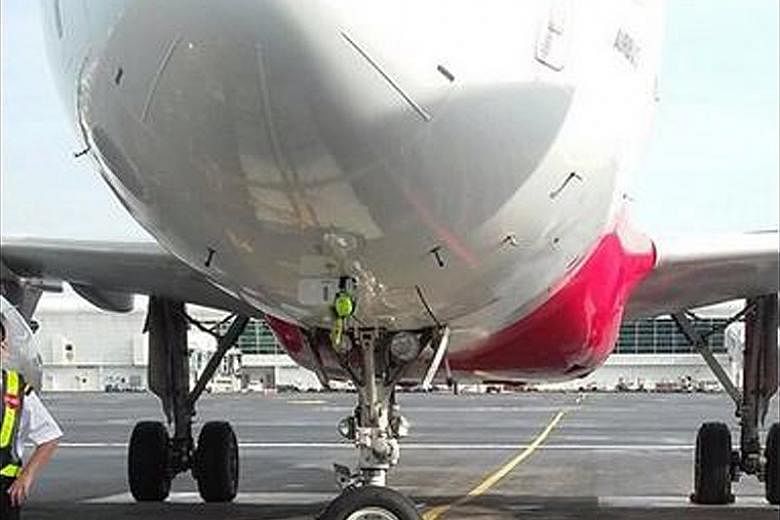KUALA LUMPUR • Discount carrier AirAsia yesterday called for urgent repairs at Malaysia's new budget airline terminal, claiming the tarmac was "sinking".
Mr Tony Fernandes, the chief of AirAsia - the terminal's biggest user - criticised Malaysian aviation officials after a plane came off its chocks, a block that braces the wheel, at the KLIA2 terminal in Kuala Lumpur on Saturday, causing an eight-hour delay.
"The wheel was bent because the aircraft went over the chock, because it's sinking," Mr Fernandes told reporters yesterday.
Since opening last year, KLIA2 has been riddled with controversy, with cracks reportedly forming on the taxiway and faulty design leading to water pools on its grounds. Costs to build KLIA2 ballooned from an initial estimate of about RM1.7 billion (S$610 million) to RM4 billion. "The airport needs to be fixed. Fix it and let's move on," Mr Fernandes said.
Malaysia Airports Holdings Bhd (MAHB) said the problems stemmed from uneven soil settlement. The settling "has been anticipated from the start of construction", the company said, adding that the airport was addressing the issue by patching and resurfacing problem areas and injecting polyurethane under the ground.
A concrete slab to be completed by next April will provide a more permanent solution, it said.
KLIA2 is not the only Asian airfield to face difficulties getting off the ground. Bangkok's Suvarnabhumi airport, which opened in 2006 atop a reclaimed swamp, suffered from cracks at taxiways and runways and faulty baggage-scanning machines. Japan's government had to reinforce landfill under Osaka's Kansai International Airport after it was found to be sinking.
AirAsia said permanent solutions must be found quickly for KLIA2. "We can't afford to have an airport where it is continuously under construction as it obstructs our operations," said Miss Aireen Omar, chief executive officer of AirAsia.
Malaysia's Transport Ministry has set up an independent audit committee, which will submit a report on issues "in due course", the ministry told Bloomberg. MAHB, which has used its own funds to rectify the situation, "will be responsible for the findings and proposed solutions", the ministry said.
AirAsia initially refused to move when KLIA2 opened in May last year, citing concerns over flight operations and security. It gave in after the government said it would stop immigration and Customs services at the old budget terminal.
"We should never have moved," Mr Fernandes told reporters in Kuala Lumpur. "I was right, the management of AirAsia was right: You should have let the ground settle, fix it, then move."
The AirAsia group of airlines flew 15.2 million passengers through KLIA2 in its first year of operation, accounting for 87 per cent of the terminal's traffic, according to MAHB data.
"If you go to the airport you can see ponding with your very own eyes," said Mr Mohshin Aziz, an analyst at Maybank. Still, he noted, "it's more of an irritation rather than a safety hazard".
Last year, local media photographed Transport Minister Liow Tiong Lai and airport officials walking on the terminal's waterlogged tarmac during an inspection.
At 257,000 sq m, KLIA2 can handle 45 million passengers, with the potential to expand. Most full-service carriers, including Malaysia Airlines, use the main KLIA terminal, which began operations in 1998 after the government relocated the capital's main airport from suburban Subang.
AGENCE FRANCE-PRESSE, BLOOMBERG

